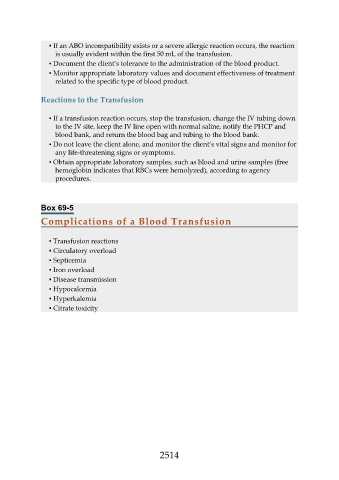Page 2514 - Saunders Comprehensive Review For NCLEX-RN
P. 2514
▪ If an ABO incompatibility exists or a severe allergic reaction occurs, the reaction
is usually evident within the first 50 mL of the transfusion.
▪ Document the client’s tolerance to the administration of the blood product.
▪ Monitor appropriate laboratory values and document effectiveness of treatment
related to the specific type of blood product.
Reactions to the Transfusion
▪ If a transfusion reaction occurs, stop the transfusion, change the IV tubing down
to the IV site, keep the IV line open with normal saline, notify the PHCP and
blood bank, and return the blood bag and tubing to the blood bank.
▪ Do not leave the client alone, and monitor the client’s vital signs and monitor for
any life-threatening signs or symptoms.
▪ Obtain appropriate laboratory samples, such as blood and urine samples (free
hemoglobin indicates that RBCs were hemolyzed), according to agency
procedures.
Box 69-5
Complications of a Blood Transfusion
▪ Transfusion reactions
▪ Circulatory overload
▪ Septicemia
▪ Iron overload
▪ Disease transmission
▪ Hypocalcemia
▪ Hyperkalemia
▪ Citrate toxicity
2514

